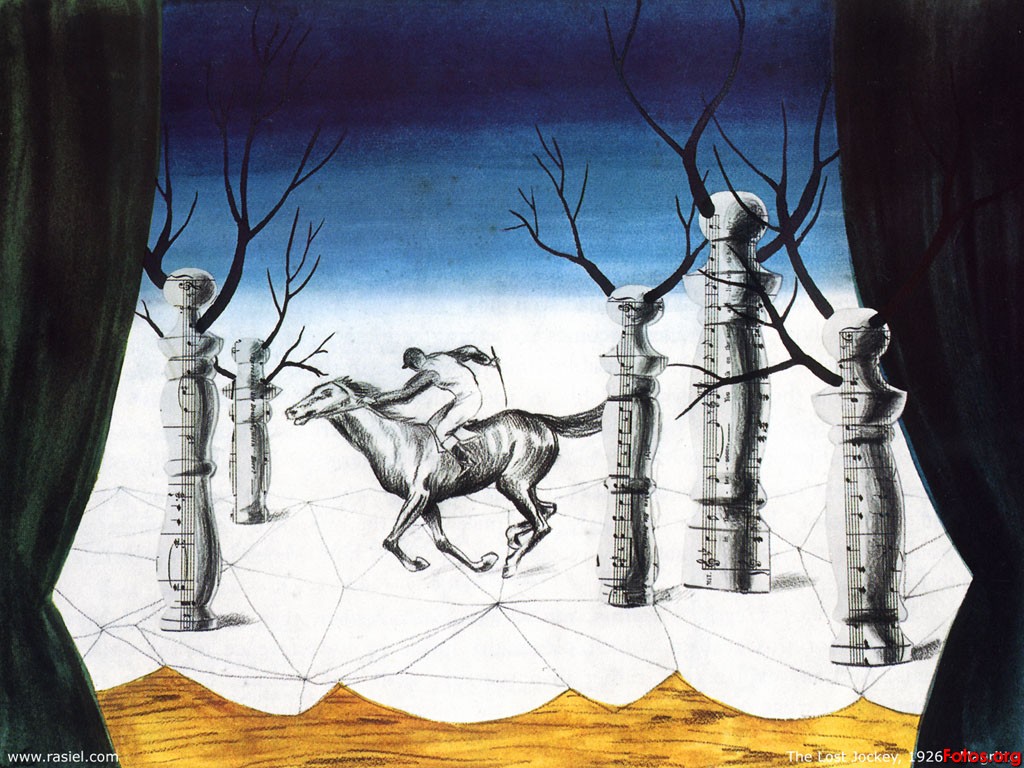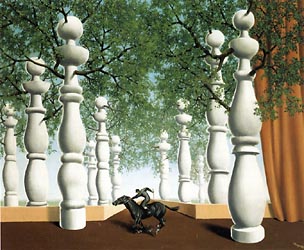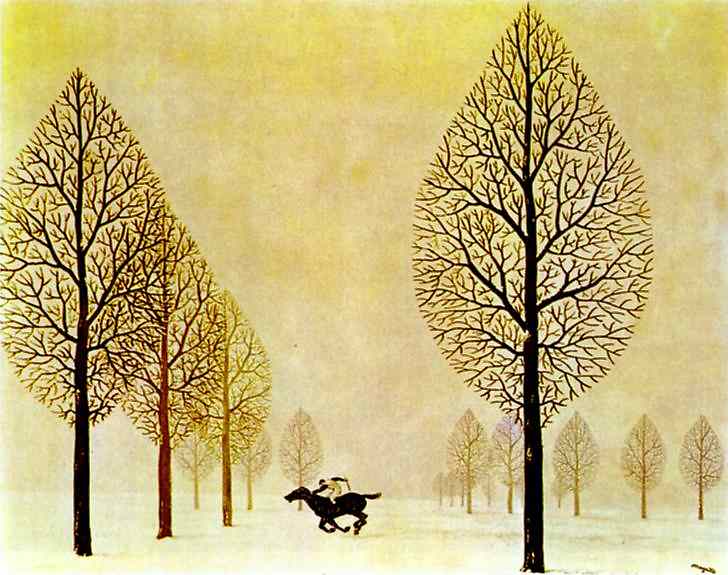Hi,
This blog we'll look at one of Rene Magritte's first surrealist paintings The Lost jockey (Le jockey perdu). Inspired by the collages of Max Ernst and the paintings of Giogrio De Chirco, Magritte began his new direction in art around 1924. Magritte was an active participant of Dadaism and the Belgiam branch surrealism which united in 1925. The Lost Jockey (Le jockey perdu) was one of a series of collages that contained the bibloquet or balluster that Magritte created in 1925-1926. He considered The Lost jockey to be his first surrealist work although several of his earlier collages would certainly qualify.
Rene designed theatre sets in Brussels in the early 1920s for Theatre du Groupe Libre. The Lost Jockey is one of many theatre settings with a curtain that Magritte produced in his early works. It also uses bilboquets that resemble trees with musical notation as bark, possibly as a tribute to Mesens, the pianist and composer and his brother Paul, a musician who studied with Mesens.

Le jockey perdu- 1926 Collage
The jockey is clearly riding on a wooden stage with curtains. The stage is covered with a white cloth with geometric patterns that are umbrella-like. The bibloquet on the right is an impossible object,existing behind and in front of the right curtain.

Le jockey Perdu- 1942: oil
Magritte revisited some of his paintings many times; most likely to paint a copy as a request for a patron. When he would redo the painting he would usually change the new version slightly from the earlier version.

Lost Jockey- 1948 gouache on paper - 25 1/2 x 19 7/8 in. (64.8 x 50.5 cm.)
Provenance: Galleria Internazionale, Milan (no. 166).
Acquired from the above by the present owner circa 1960s.
Notes: Le jockey perdu is one of the largest format gouaches by René Magritte, a variation of one of the artist's favourite themes, the crazily displaced horse racing with its rider through an incongruous landscape. In this gouache, Magritte has introduced several other motifs as well: floating above the lost jockey of the title is a mysterious sphere, while the entire scene is shown through a strange, rocky portal, as though the viewer were in a colossal cave at the edge of this flat scrubland.
Magritte first tackled the theme of Le jockey perdu in 1926, a watershed period for the artist, in which he suddendly found a means of exposing the mysteries of the world, the poetic associations between the objects that form our reality and which we take all too much for granted. His strange juxtapositions challenged the viewer, demanding that we consider afresh the properties of the everyday elements of the world around us. So, in this gouache of Le jockey perdu, it can be seen the racetrack that would usually play host to a jockey is absent, the racer taken out of context. At the same time, a strange new planet hovers as though within the atmosphere of the Earth; this ball has replaced the sun and the moon; its looming presence adds a cosmic oddness to the entire picture.
It is a tribute to the importance of this theme that Magritte himself would write, with reference to his original oil of the subject, that 'Le jockey perdu (The Lost Jockey) is the first canvas I really painted with the feeling I had found my way, if one can use that term' (R. Magritte, quoted in H. Torczyner, Magritte: Ideas and Images, translated by R. Miller, New York, 1977, p. 48). Magritte's own revelation had occurred when he had seen a painting by Giorgio de Chirico. Presenting the viewer with an eccentric assortment of seemingly unassociated objects, de Chirico's Le chant d'amour introduced the viewer to a realm in which another hidden logic appeared dominant. While the mysticism of de Chirico did not influence Magritte, the break with perceived reality and the use of juxtapositions did. For this reason, Magritte denied the open influence of de Chirico, making specific reference to his first version of Le jockey perdu:
'If one takes into consideration what I've painted since 1926 (Le jockey perdu-1926-- for example, and what followed), I don't think one can talk about 'Chirico's influence' I was 'struck' about 1925 when I saw a picture by Chirico Le chant d'amour. If there is any influence it's quite possible there's no resemblance to Chirico's pictures in Le jockey perdu. In sum, the influence in question is limited to a great emotion, to a marvellous revelation when for the first time in my life I saw truly poetic painting. With time, I began to renounce researches into pictures in which the manner of painting was uppermost. Now, I know that since 1926 I've only worried about what should be painted. This became clear only some time after having 'instinctively' sought what should be painted' (R. Magritte, quoted in ibid., p. 258).
As in several of Magritte's strongest works, Le jockey perdu is made all the more visually striking by the contrast between stillness and dynamism, here articulated by the difference between the speed of the jockey and the emptiness of the landscape around him. Where de Chirico's works were often marked by an intense sense of poise and stillness, Magritte has prompted the viewer into a profound investigation of everyday elements, items and qualities from the world around us such as movement, horses, gravity and the celestial bodies.